The LG G3 Review
by Joshua Ho & Anand Lal Shimpi on July 4, 2014 5:00 AM EST- Posted in
- Smartphones
- LG
- Mobile
- Laptops
- G3
CPU Performance
By now, the Snapdragon 801 is mostly well-understood. It has four Krait 400 cores at either 2.26 or 2.45 GHz, an Adreno 330 at 578 MHz, a faster ISP, DSDA support, and higher clocks on the memory interface, along with support for eMMC 5.0 for faster NAND speed. However, OEM design choices can have significant effects on the relative performance of a device. For example, the Galaxy S5 trailed behind the HTC One (M8) despite a faster SoC due to worse thermal dissipation. This was because water resistance necessitated a new design that effectively encased the SoC in a polycarbonate cage, trapping heat in. The LG G3 has the same SoC and same build materials as the Galaxy S5, but the midframe is magnesium, not polycarbonate. This means that peak performance can be higher than the Galaxy S5.
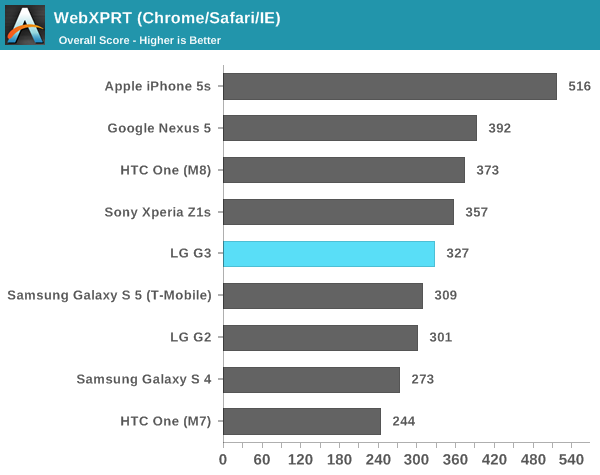
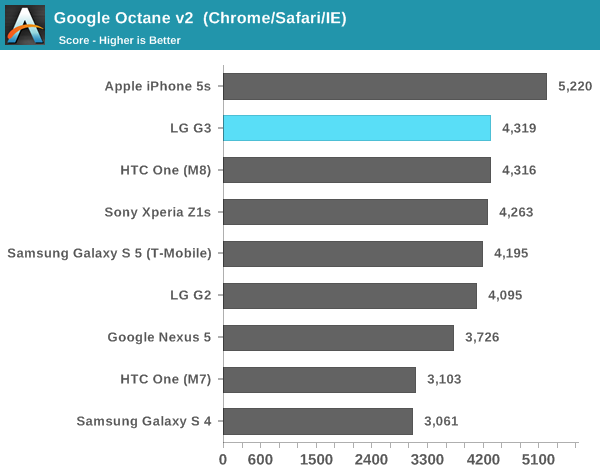
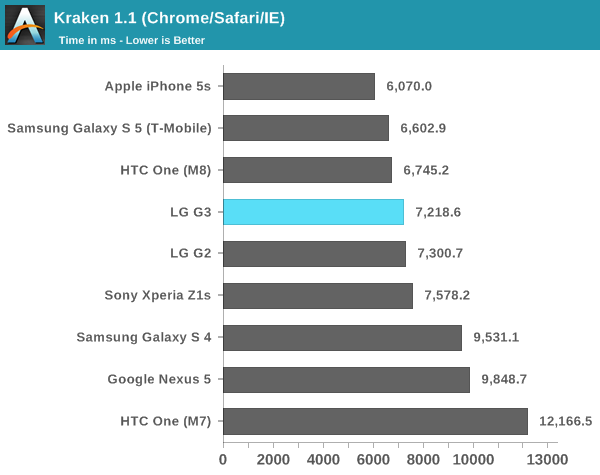
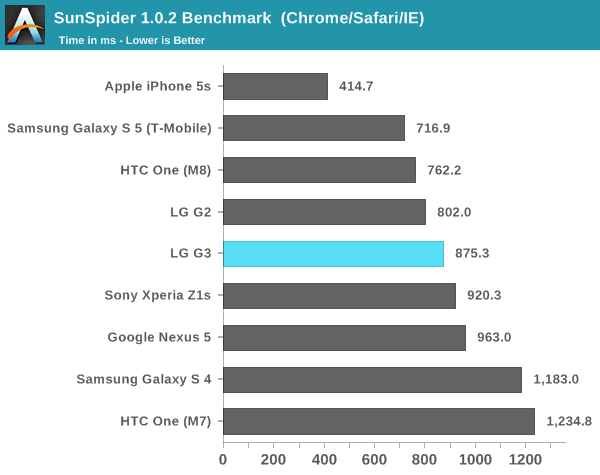
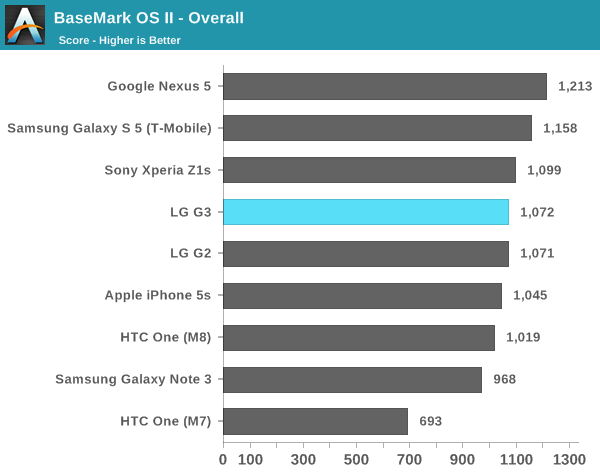
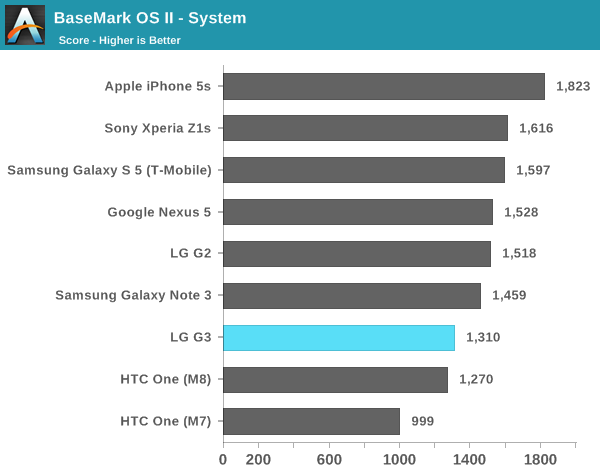
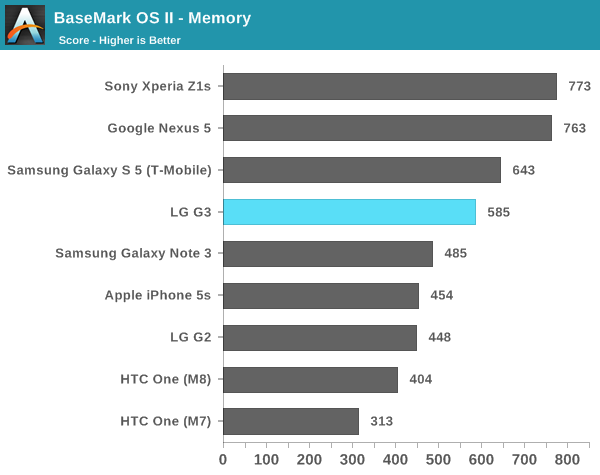

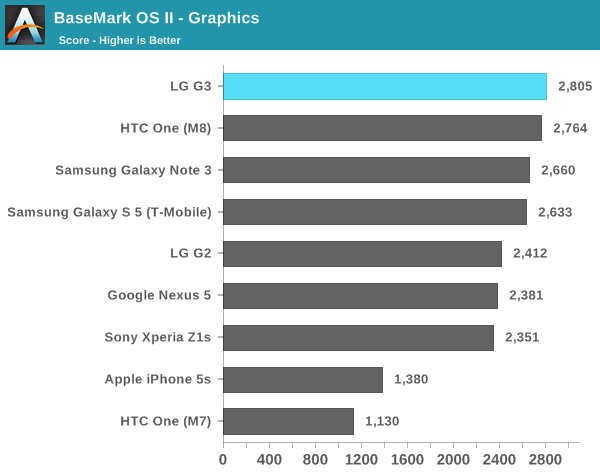
Relatively speaking, there's not much in the way of interesting things to talk about here, despite the new configuration. The G3 seems to trail the other S801 devices in web performance but it seems to depend upon the benchmark. This seems to be partially because of the G3's willingness to throttle, or because of the display's heat output. Either way, the trend is clear because of how often the display brightness is capped to 90 or 95 percent of the maximum to cool off the phone. When this isn't an issue though, the short benchmarks tend to show the faster performance of the G3.
GPU Performance
While the state of CPU benchmarking is heavily subject to difference in the performance of the web browser, things are a bit better in the GPU side. All Snapdragon 801 SoCs have the same GPU clocks, so this means that it'll be much easier to examine throttling behavior and reduce variability due to confounding factors.
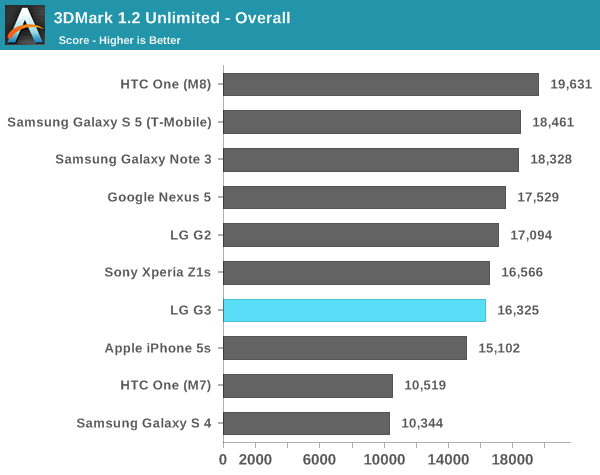
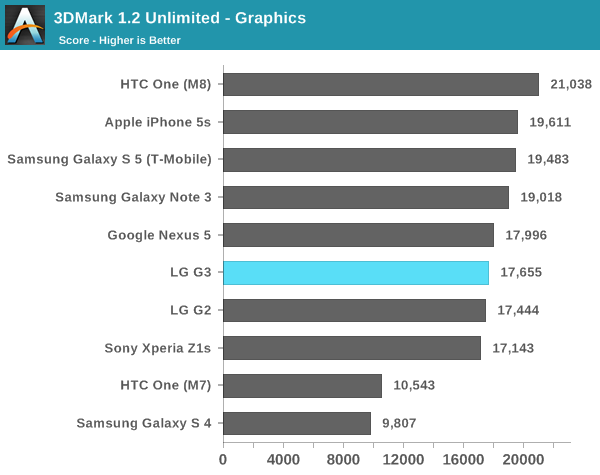

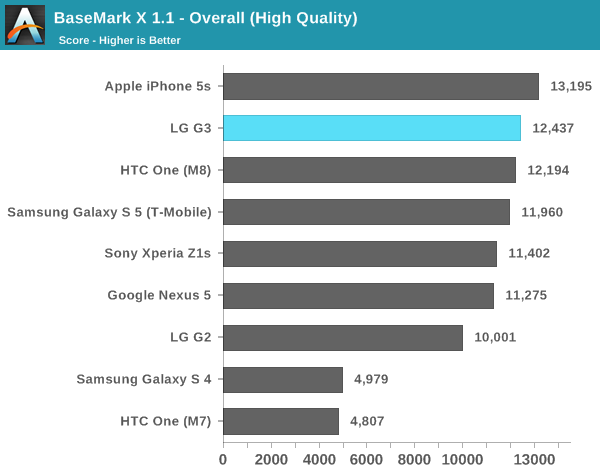
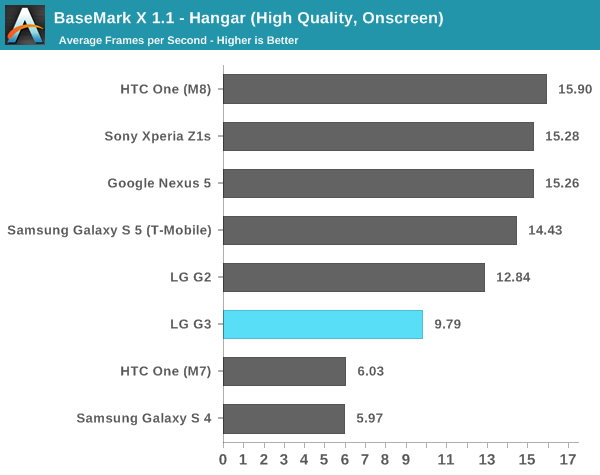
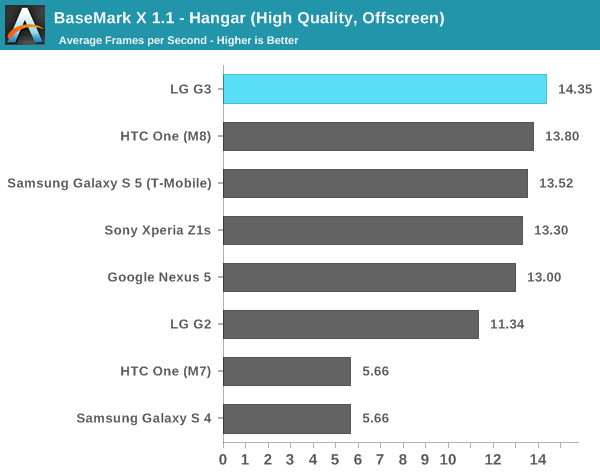
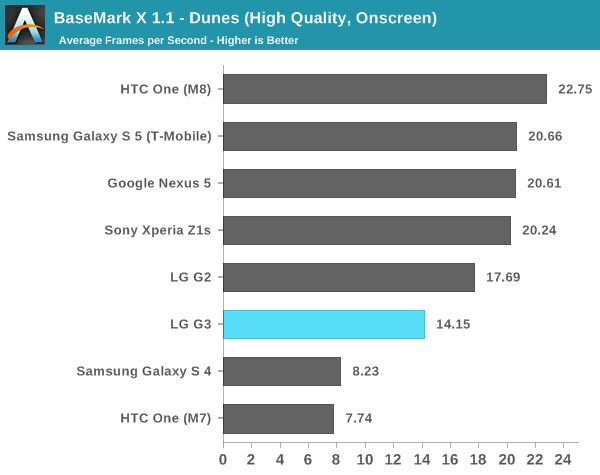
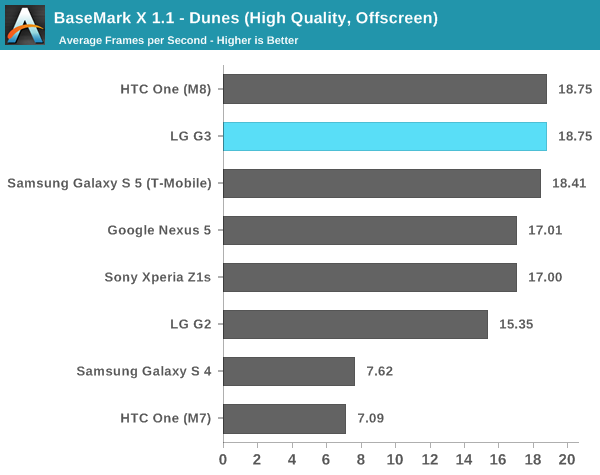
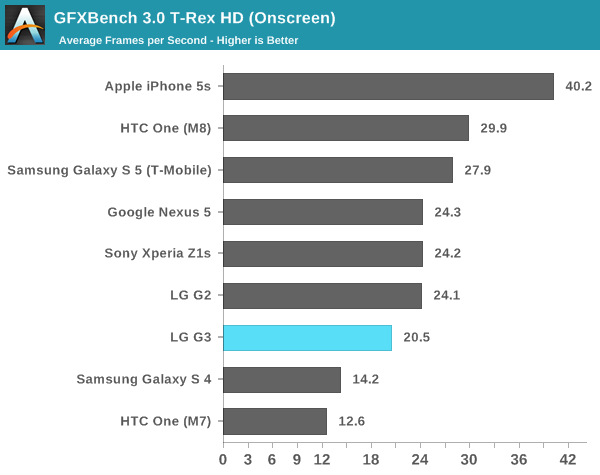
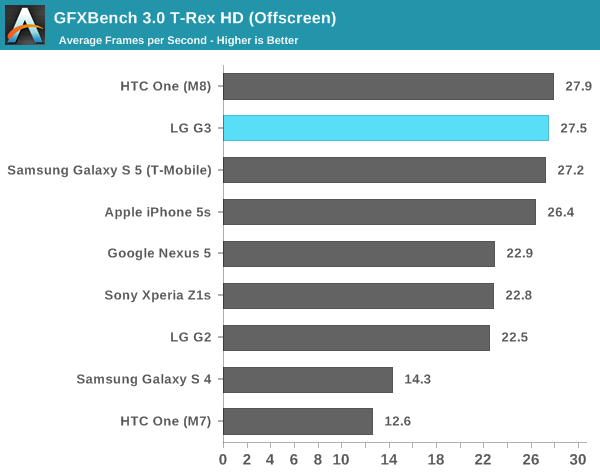
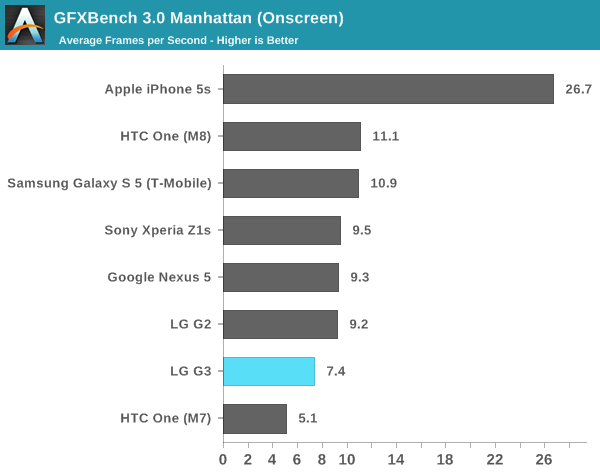
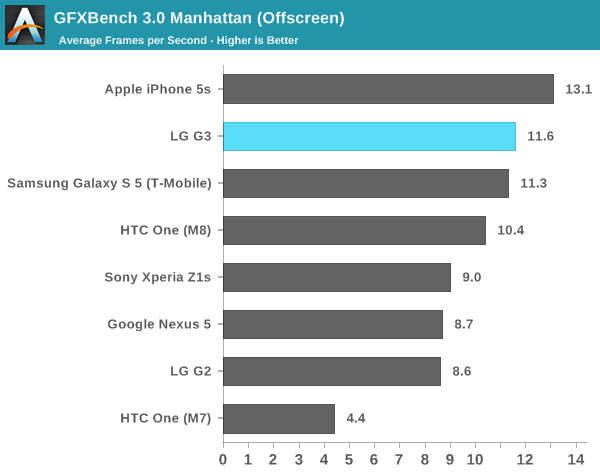
Here, we can see a noticeable trend. In the short tests, the LG G3 does great, easily nearing the top of the scores. However, 3DMark's extremely long-running test means that the G3 noticeably suffers in performance compared to the competition, and this is worsened by the G3's sinusoidal throttling patterns that cause significant degradation of performance for periods of time to balance out the high performance periods. On the on-screen tests, the G3 does worse than the high-end competition, which suggests that QHD/1440p truly does need Snapdragon 805's Adreno 420 in order to keep real-world performance from regressing relative to the Snapdragon 801, 1080p-screened counterparts.
NAND Performance
NAND performance used to be an afterthought, and effectively never discussed in most reviews. However, after the original Nexus 7 revealed the headaches that come with poor I/O performance this metric has increasingly come under greater scrutiny. To quantify this performance, we turn to Androbench with custom settings to evaluate Android smartphones.
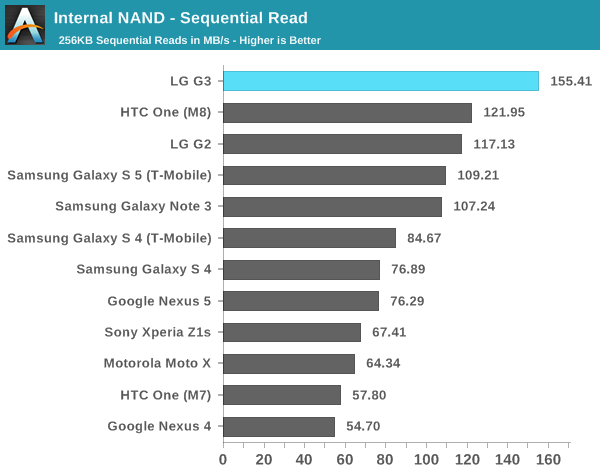
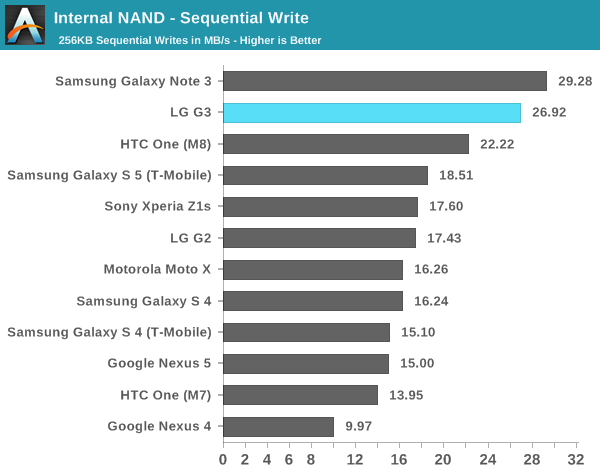
Here, the G3 is off to a great start. The sequential read speeds set new records and sequential write speeds are almost as good as it gets. This means that LG isn't cheaping out on NAND, which means that shooting 4K video and similarly intensive situations won't be a problem on the G3. However, random I/O performance is much more important as that's where people will notice poor performance in the form of stuttering and pauses.

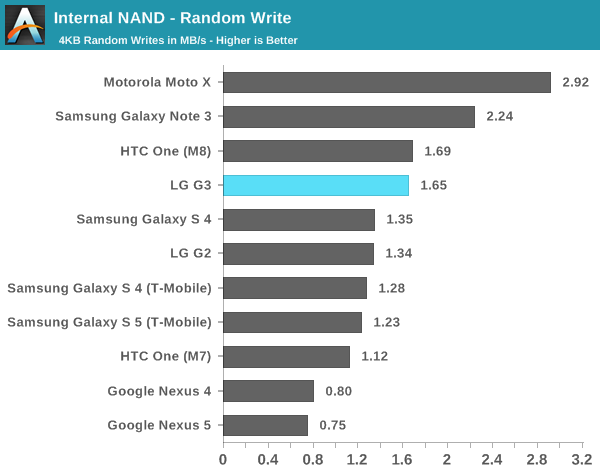
Here, we see a similar pattern. The LG G3 does great in random reads, but random write isn't quite as great. It's still perfectly usable and shouldn't present any problems for smoothness or general performance. The Moto X continues to hold its considerable lead here due to its F2FS file system that allows for much faster random I/O performance. Overall, the LG G3 shouldn't have any issues with I/O pauses, although you should still keep around 25% of your storage open to keep up I/O performance.










174 Comments
View All Comments
Mumrik - Sunday, July 6, 2014 - link
"even if it’s a bit off-putting that LG is trying to make plastic feel like metal. "I'm generally not a fan of that either, but surely it's better than Samsung working hard to make plastic feel even cheaper?
rlab_joo - Sunday, July 6, 2014 - link
I wouldn't worry about battery life too much. The devs, and rom creators, at xda developers, haven't got to it yet, you can do wonders there.CoryS - Monday, July 7, 2014 - link
No...people convince themselves they do wonders. In reality custom roms usually hurt battery life, and custom kernels have hosts of other issues.Sunsmasher - Monday, July 7, 2014 - link
This is by far the most thorough, insightful and intelligent review that I've seen on the LG G3.I own the G2, and this review gave me more valuable information than any other review that I've read (and I've read many, many of them). Kudos to Joshua and Anand!
rocktober13 - Monday, July 7, 2014 - link
Is it worth the extra $100 or $200 over the G2? I have an upgrade coming up on Verizon. I don't like the M8 with the wasted space from the HTC logo, and my wife has the GS5 so I can't get that ;).Also, I heard there is a 2GB and 3GB version; would there be any noticeable difference in performance?
yvn - Monday, July 7, 2014 - link
I was so gonna get this phone as I hoped the display would be the best in regards to color accuracy....i am very disappointed now :(djc208 - Tuesday, July 8, 2014 - link
My biggest problem with my original Optimus G has been LGs speed in updating the software. There are reports that we might get one last bump to 4.4 kitkat, otherwise they they haven't released an upgrade since they went to 4.2, which is sad considering it's essentially the same phone as the Nexus 5, so Google practically does all the work for them.Meanwhile the SGS4 is already running 4.4.
phoenix_rizzen - Friday, July 11, 2014 - link
Optimus G is the same phone as the Nexus 4, not the Nexus 5 which is based on the LG G2.The OG is very easy to root and install custom ROMs onto. There's a vibrant community of devs working on the OG on XDA. My OG died before I could test Android 4.4 on it, but it ran beautifully with RootBox (Android 4.2.2) and Carbon (Android 4.3.1). ParanoidAndroid, SlimBean/SlimKat, and a handful of others are also available.
I tried to like the LG version of Android, but just could not get over the colour scheme (too bright for me; physically painful to use in the dark, even at low brightness). The only part of the LG ROM I liked was the handwriting recognition in the keyboard. However, the gesture feature of the AOSP keyboard is much nicer to use. :)
PETER WONG - Tuesday, July 8, 2014 - link
Finally this morning Google help me to install Candy Crush in G3Shan83 - Wednesday, July 9, 2014 - link
Guys, people who are using this phone for quite some time, please do share your thoughts about "overheating" of G3 being mentioned by people.Is it abnormally getting heated even upon moderate usage / playing low graphic intense game or continuous Wi-Fi usage?
Please comment.